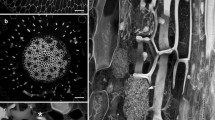Summary
Three successive states are recognized in the development of endodermal cells in seminal and nodal axes and primary lateral roots of barley: 1. Casparian bands in the anticlinal walls; 2. suberin lamella around the whole inner face of the wall; 3. unevenly deposited cellulosic wall thickening. These states develop asynchronously, the cells adjacent to the protoxylem pole cells always being last to mature. All cells have progressed to at least the secondary state by 32 cm from the tip in seminal axes, 48 cm from the tip in nodal axes, but only 6 cm from the tip in primary laterals. The asynchronous development gives the appearance of “passage” cells adjacent to the protoxylem pole cells, although all cells eventually attain the same state and degree of wall thickening. Long distance transport of calcium shows a close correlation with the incidence of suberin lamellae in the three types of root examined; it is suggested that formation of a suberin lamella effectively blocks calcium movement into the stele and, therefore, long distance transport. Plasmodesmata are present in comparable frequencies through both tangential and radial endodermal walls; they appear to maintain intercellular continuity until a late stage in development.
Similar content being viewed by others
References
Bonnett, H. T. Jr., 1968: The root endodermis: Fine structure and function. J. Cell Biol.37, 199–205.
Clarkson, D. T., A. W. Robards, andJ. Sanderson, 1971: The tertiary endodermis in barley roots: Fine structure in relation to radial transport of ions and water. Planta (Berl.)96, 292–305.
- and J.Sanderson, 1971 a: Relationship between the anatomy of cereal roots and the absorption of nutrients and water. Agricultural Research Council Letcombe Laboratory Report 1970, 16–25.
— —, 1971 b: Inhibition of the uptake and long-distance transport of calcium by aluminium and other polyvalent cations. J. Exp. Bot.23, 837–851.
- - 1972: The time-course of the accumulation of calcium in the various tissues of the roots of barley seedlings. Agricultural Research Council Letcombe Laboratory Report 1971, 4–6.
- - (in preparation): Rates of phosphate and calcium accumulation in various tissues in intact roots of barley: Results from quantitative autoradiography.
— —, andR. S. Russell, 1968: Ion uptake and root age. Nature220, 805–806.
Esau, K., 1965: Plant anatomy. New York: Wiley.
Falk, H., undP. Sitte, 1963: Zellfeinbau bei Plasmolyse. Protoplasma57, 290–303.
Hackett, C., 1968: A study of the root system of barley. I. Effects of nutrition on two varieties. New Phytol.67, 287–300.
Heimsch, C., 1951: Development of vascular tissues in barley roots. Amer. J. Bot.38, 523–537.
Helder, R. J., andJ. Boerma, 1969: An electron microscopical study of the plasmodesmata in the roots of young barley seedlings. Acta bot. neerl.18, 99–107.
Jackson, V. G., 1922: Anatomical structure of the roots of barley. Ann. bot.36, 21–39.
Merry, J., 1941: Studies on the embryo ofHordeum sativum. I. The development of the embryo. Bull. Torrey bot. Club68, 585–598.
Mollenhauer, H. H., 1964: Plastic embedding mixtures for use in electron microscopy. Stain Technol.39, 111–114.
Reynolds, E. S., 1963: The use of lead citrate at high pH as an electron opaque stain in electron microscopy. J. Cell Biol.17, 208–212.
Robards, A. W., 1971: The ultrastructure of plasmodesmata. Protoplasma72, 315–323.
—, andMarlene E. Robb, 1972: Uptake and binding of uranyl ions by barley roots. Science (NY)178, 980–982.
Russell, R. S., andJ. Sanderson, 1967: Nutrient uptake by different parts of the intact roots of plants. J. Exp. Bot.18, 491–508.
—, andH. M. Squire, 1958: The absorption and distribution of strontium in plants. I. Preliminary studies in water culture. J. Exp. Bot.9, 262–276.
Spurr, A. R., 1969: A low-viscosity epoxy resin embedding medium for electron microscopy. J. Ultrastruct. Res.26, 31–43.
Tanton, T. W., andS. H. Crowdy, 1972: Water pathways in higher plants. II. Water pathways in roots. III. The transpiration stream within leaves. J. Exp. Bot.23, 600–618, 619–625.
Author information
Authors and Affiliations
Rights and permissions
About this article
Cite this article
Robards, A.W., Jackson, S.M., Clarkson, D.T. et al. The structure of barley roots in relation to the transport of ions into the stele. Protoplasma 77, 291–311 (1973). https://doi.org/10.1007/BF01276765
Received:
Issue Date:
DOI: https://doi.org/10.1007/BF01276765




